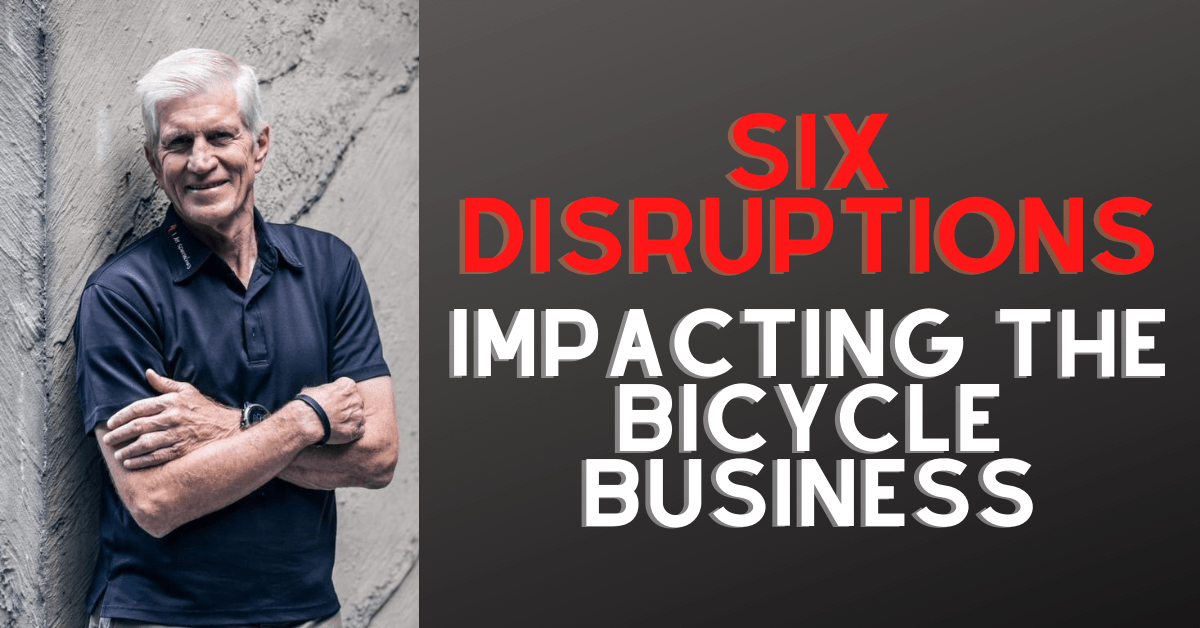Six Disruptions Impacting the Bicycle Business
As we enter a new decade, technology and demographic changes are disruptions impacting bicycle business and will continue to drive evolution and innovation within the industry.
We are now in a technology world filled with surprising innovations that are changing the way we move. They are also changing the industry’s landscape for products, channels, and customers. It’s not evolution; it’s a revolution.
Six disruptions impacting the bicycle business:
- Share-bikes and share-scooters: The sharing community is growing at a geometric pace as a dependable transportation solution for the final kilometer. Major players like Lyft, Uber, DiDi, Lime, and Bird have multi-billion-dollar valuations with strong capital and significant resources to innovate and execute mobility solutions.
- Market leaders are maturing and promoting socially responsible activities by cooperating with local, state, and federal governments on safety, usage, data sharing, safe cycling routes, infrastructure development, and city planning. There is a stronger emphasis on user education while providing rewards for safe and responsible use.
- These businesses rely on subscription-based, per-user revenue streams, rather than traditional purchases. Customer referrals, connected networks, and satisfied customers are the ingredients for valuation and equity growth. This creates an eco-system that leads to creative solutions that further stimulate usage and build loyal customers and strong communities.
- The continually evolving global GPS network and the massive amounts of captured data provide a bonus revenue stream while serving as a blueprint for efficiency gains, product innovation, monitoring usage patterns, and accurate user demographics. The ambitious vision, “a share bike or scooter on every corner in every city around the world,” is happening.
- E-bikes: The market is transitioning to e-bikes. Some predict that within ten years, more than 90 percent of all bikes sold will be e-bikes. Recently the EU announced that more than 30 million e-bikes would be sold per year. Double the number of automobiles sold annually.
- Countries worldwide are incentivizing both purchases and usage with substantial tax credits. City planners are building safe bike lanes and secure parking structures complete with universal charging stations to encourage e-bike use. Utility e-bikes are commonplace in major cities as delivery services realize the commercial, economic and environmental benefits of e-bike.
- From the product side, technology is changing everything—smaller, more powerful motors and lighter, simpler, longer-life batteries, robust frame structures, low-maintenance components, and higher quality construction are driving customer satisfaction. Costs and retail prices decline as economies of scale make e-bikes the product of choice for transportation, utility, sport, recreation, and performance.
- The price/value gap between traditional bicycles and e-bikes is narrow, which encourages e-bikes purchases. New retail e-bike outlets pop up as sales, customer care, and maintenance need become an essential part of satisfying consumer demands.

- Customization: With the evolution of e-bikes, traditional bikes are moving to super high value. They are precise, high-performance machines satisfying the passionate lust for untethered speed. The demand for custom bicycles is exploding.
- Unique configurations, colors, cosmetics, and components need to be personalized to communicate individuality while optimizing the riding experience. Customization becomes localized to satisfy immediate customer demands. New brands offer a range of colors, sizes, and configurations, satisfying the most demanding buyers—and turning a profit.
- Traditional legacy brands are pivoting into customer-focused operations, abandoning generalization. “Made Locally” has a special meaning as individuality and support of local businesses stress strong growing communities.
- E-Commerce: Channel changes continue to reflect consumer buying habits like shopping, and purchase preferences shift to digital devices. On-line sales of bikes, branded components, soft goods, and accessories continue to grow as digital platforms, rapid response, and on-demand customer service drive buying decisions. Global e-commerce purchases will continue to evolve as new outlets enter the mix as consumer trust and confidence build.
- Indoor Fitness: The fastest-growing cycling market segment is indoor fitness. Technology integration of entertainment, star-status instructors, social media interaction, and advances in artificial intelligence (AI) has exploded within the indoor training sector.
- Established players like Zwift, Sufferfest, Trax, Garmin, Saris, Peloton, Flywheel, Wahoo, TDF, Stages, and others continue to innovate in software, products, and platforms to draw, excite, captivate and retain users. Social media attention and global networks are revolutionizing fitness as fashionable, fun, competitive, and inspiring.
- Traditional cyclists find indoor training a refuge from distracted drivers, unpredictable weather conditions, unexpected maintenance issues, and bad air quality. It’s an easy, safe, and productive way to stay healthy and fit.
- Participation in indoor fitness continues to grow as a permanent solution to ensuring personal health and fitness. Medical insurance companies are incentivizing indoor fitness as a means to a longer, healthier, drug-free life. Future Innovations like augmented reality (AR), the Internet of Things (IoT), and gaming will further enhance the user experience, add excitement, and drive usage.
- Kids: Youth will drive the future: Kids ride bicycles to learn, fun, health, coordination, and transportation. Parental engagement—bundled with simplicity, joy, and freedom—means children can fuel the cycling experience. Advanced tracking devices, health monitors, and integrated safety features allow parents to permit kids to ride. Building confidence and fun into youth cycling will provide the industry’s biggest payback. Cycling expands kids’ realm of influence, builds social skills, and develops lifetime friendships. Youth continue to be our best long-term investment in the future.
As you reflect on these market disruptions, think of ways to adapt and capitalize on them. These and other disruptive changes provide opportunities for those who recognize them and successfully serve them.
Words by Bob Margevicius
 The NBDA has been here since 1946, representing and empowering specialty bicycle dealers in the United States through education, communications, research, advocacy, member discount programs, and promotional opportunities. As shops are facing never-before-seen circumstances, these resources offer a lifeline. Together, we will weather this. We at the NBDA will not waver in our commitment to serving our members even during this challenging time—but we need your support.
The NBDA has been here since 1946, representing and empowering specialty bicycle dealers in the United States through education, communications, research, advocacy, member discount programs, and promotional opportunities. As shops are facing never-before-seen circumstances, these resources offer a lifeline. Together, we will weather this. We at the NBDA will not waver in our commitment to serving our members even during this challenging time—but we need your support.
Now is the time to become a member as we join together to make one another stronger. Whether you’re a retailer or an industry partner, your membership in the NBDA is one of the best investments you’ll make this year.
Learn more about the benefits of being a member and join now.









